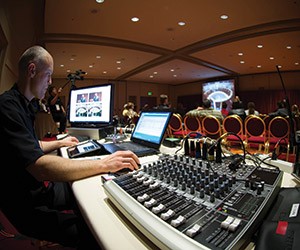Even the most experienced planners of large meetings can feel like a fish out of water when organizing their first major overseas convention, where even some of the most basic assumptions and contract terms are vastly different than in North America.
Outside of North America, planning a large convention can be daunting for a newbie. When going worldwide for the first time, the dynamics are intensified because—depending on the host destination—logistics will transpire differently, sometimes even in the way registration is handled. The finer details of the hotel contracts will need to be negotiated differently, as will the transportation. One cannot take anything for granted.
Just because one has planned conventions across the U.S. doesn’t mean he or she can effortlessly scale the business overseas. Everything is more expensive and more complicated, and no matter how obvious all of this may sound, experts have witnessed many an occasion where a planner has overlooked the finer details and failed spectacularly.
Going it alone, suffice it to say, is a very poor strategy.
Getting In Line
At the outset of a large international congress, the host may have different expectations during the registration process. Jean-Paul de Lavison, president and founder of Montreal-based JPdL International Convention Management, says he is seeing many planners of international conferences say it’s not important to hire extra people just to make lines go faster at registration. That’s because having an initial mass-crunch of registrants queueing up at the tables is not as big an issue as it is for large conferences in North America.
“The international conferences are often a lot more tolerant of that,” de Lavison explained. “Whereas in North America, the perception is that it doesn’t look very well organized. There’s a sense that it should look really immaculate, and that you can’t show up and have 15 people in line in front of you. There’s usually no tolerance for that.”
But this isn’t always the case overseas.
“The international conferences might not be so demanding,” de Lavison says. “We’ve been seeing that they’re unwilling or unable to pay to staff up just to handle a 20-minute crunch period at registration.”
Every detail is amplified when going international. The food and beverage component will be different so delegates with allergies must be taken into consideration much more than at home, and the hosts might not be proactive in asking if delegates have special dietary requirements.
Depending on the location, ADA-compliance-type laws may not exist, so delegates with physical handicaps need to be addressed with more scrutiny. Also, the host city or country may have a national holiday that falls during the desired dates of a convention, which is why partnering with local contacts who know the area’s calendar is imperative.
Contract Talks
When it comes to contract negotiations for a large congress overseas, the process can be dramatically different than it is in the states. Planners will discover proprietary details that they probably won’t find when hashing out contracts for large domestic conventions. David Bruce, managing director of CMP Meeting Services, says contract details are a prime example of how different it can be to organize a large international convention.
“In a nutshell, you’re dealing with contracts that are far less negotiable than we’re used to here in the United States,” he explains. “As much of a language barrier as there is between England and the U.S., it intensifies when you’re talking to France, Germany, Russia or wherever you may be. For example, some countries have returnable VATs that you can get. If you don’t know that, you won’t get that.”
In Europe, big box hotels with huge amounts of meeting space are much less common than in the U.S. or Asia. Many major European cities only offer a handful of hotels in the 300-500 guest room range. The competition thus affects how properties negotiate contracts.
“When it comes down to complimentary meeting space over there, that’s a rarity,” Bruce says. “Here it’s pretty normal. Just something as small as that can cost you tens of thousands of dollars if you don’t know how to get around that and how to discuss it with a property.”
Norah Marr, global accounts director and director of international marketing and strategic partnerships for ConferenceDirect, says she even uses several different contract shells overseas, each one tailored for specific continents or countries. Allowing time for negotiation is key, she explains, adding that the process is slower everywhere else in the world. Plus, there exist idiosyncrasies with how different countries hash out room packages, meal packages and the amount of attrition or slippage allowed on room blocks.
“Attrition is omitted in a lot in international contracts,” Marr says. “So by that not being part of the contract, it doesn’t mean you’re safe; you have to address it.”
“Also,” she adds, “some international hotels expect you to pick up 100 percent of the block—no matter what. So if you don’t see slippage mentioned in the contract, you must add it. The same goes for food and beverage.”
Traffic Jam
Similar issues emerge when organizing transportation. If a planner initially is confused about how to move thousands of delegates from the congress center to the after party when English isn’t the mother tongue of the land, partnering with an experienced organization on the ground is crucial.
“There are a few things you have to keep in mind,” de Lavison says. “If you go to Europe, you can go to three different countries in 150 miles. You have the language, the culture, local rules; there are so many different things going on. So to work with a local company—like you would with a DMC in America—you want that. And you don’t want a one-man show, like a freelancer.”
A local partner with knowledge in international business is even more important.
The transportation should be organized with a partner who understands that North Americans have different expectations. For example, many international hosts, for cultural reasons, will place a higher priority on the quality of food and drink at dinner than whether or not your hired bus drivers are ever on time, so the arrangements can pose a serious dilemma. Bruce says the process is an entirely different animal than what American planners are accustomed to experiencing.
“To move large groups requires many buses, which aren’t as plentiful overseas as they are in the United States,” he explains. “It takes far more negotiation with the transportation company to express your need for not only being on time, but being available. Also the cost of everything, especially gas prices, is higher.”
In the end, when a large international congress with thousands of people finally concludes, de Lavison explains that the following year’s event tends to get promoted much more than an equivalent convention that rotates within North America. Since international congresses tend to rotate around the world, the hosts of the next event—as well as the planners—need to bring much more to the table in terms of promotion.
“Late in the convention, at international meetings, they put a bigger effort and bigger energy into promoting the following year’s convention,” de Lavison explains. “The venues, the cities and the countries will invest more money and more resources. It’s done to a certain scale in North America, but it seems to be done on a big scale for international conferences. In North America, between the destinations, the [organizers] may already have been there a few years earlier—five, 10 years ago—but in international, it tends to move to different corners of the globe. So it’s a bigger deal and they push it harder.”
Way back in the 1990s, Gary Singh administratively assisted six international conferences while completing a Masters Degree in Art & Technology.







